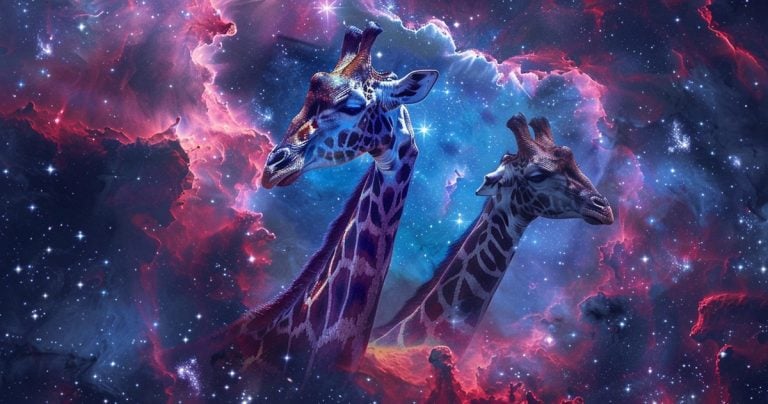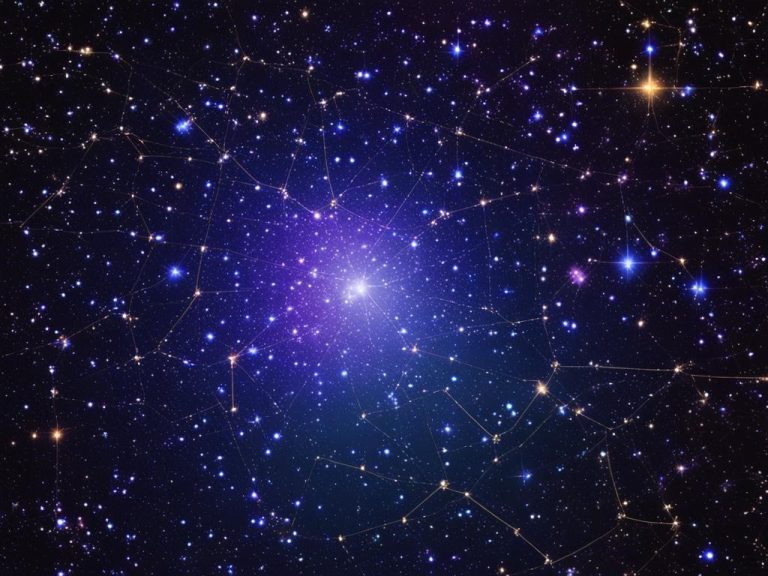Explore the Camelopardalis Constellation Guide
Modified: September 1, 2024 Author: International Star Registry
Did you know the Camelopardalis Constellation is the 18th largest in the sky? It covers a big area in the north but is hard to see because it doesn’t have many bright stars. Still, for those who love looking at the stars, it’s a place full of amazing finds.
This group of stars belongs to Ursa Major, the Big Bear constellation family. It has several stars and things like CS Camelopardalis and Sigma 1694 Camelopardalis. The brightest is Beta Camelopardalis. There are also open star clusters, like NGC 1502, and nebulae, including the Oyster Nebula (NGC 1501).
Whether you’re new to looking at the stars or just love the night sky, Camelopardalis is special. It’s full of stories and cool things to see. This guide will show you the way, making your night sky adventure unforgettable.
Get your telescope ready. It’s time to explore the wonders of the Camelopardalis Constellation like never before!
Key Takeaways:
- The Camelopardalis Constellation is the 18th largest constellation in the sky.
- Despite its lack of bright stars, Camelopardalis offers numerous celestial wonders to explore.
- Beta Camelopardalis is the brightest star in this constellation.
- Camelopardalis is home to open star clusters like NGC 1502 and nebulae such as the Oyster Nebula.
- By diving into the mythology, history, and practical tips for observing, you can fully appreciate the beauty of Camelopardalis.
The Mythology and Significance of the Camelopardalis Constellation
The Camelopardalis constellation, known as the Giraffe, doesn’t have old myths tied to it. It was spotted in 1624 by the Polish star expert, Johannes Hevelius. He pointed it out and named it around that time, making it a newer find.
This group of stars is important even without ancient tales. Its name means “giraffe” in Latin. This is because the stars look like a creature with the neck of a camel and the spots of a panther.
Adding Camelopardalis to the list made by Claudius Ptolemaeus centuries ago was a big step. It showed how our understanding of the sky grows. Now, it’s one of 88 known constellations. It fills up a big patch of the sky, spreading over 757 square degrees.
Beta Camelopardalis shines brightly in this constellation. It’s actually two stars that circle each other. They’re 1,000 light years away from us. This pair is the most visible star of the bunch, glowing at a magnitude of 4.03.
There’s also CS Camelopardalis, a star system with a blue-white supergiant and its faint companion. It’s much farther from us, about 3,000 light years. But its beauty and uniqueness are still outshining many others in the constellation.
The Camelopardalis constellation may not have age-old stories, but it’s still magical. It shows us Kemble’s Cascade, a line of over 20 stars that form a beautiful picture. This feature makes the sky even more special when gazing at it.
Want to know more about Camelopardalis and what makes it stand out? Check out these sources:
– universetoday.com
– wikipedia.org
– constellation-guide.com

Continue Reading: Discovering Camelopardalis: Finding and Observing Tips
Discovering Camelopardalis: Finding and Observing Tips
Want to start your journey through the night sky? The Camelopardalis constellation is an amazing place to start. You can find it in the northern sky between Ursa Major and Cassiopeia. It’s visible for most of the year in the Northern Hemisphere.
Since it doesn’t have many bright stars, finding it might be tricky at first. But don’t worry. I’ll share some tips to make finding and viewing Camelopardalis easier.
Using a Camelopardalis Star Map
One top way to find your way in the stars is with a star map. A Camelopardalis star map shows where the constellation is and how it looks. It helps you spot the important stars and patterns of Camelopardalis. With a star map, you can see what makes this constellation unique.
Optimal Stargazing Conditions
To see Camelopardalis at its best, head to a place with little light around. Dark, rural spots are perfect. They make the night sky much clearer, so you can see Camelopardalis’ stars better.
Try to go stargazing on nights that are clear and without many clouds. This way, you’ll get the best view of Camelopardalis.
Observing the Astronomical Wonders
Once you’ve found Camelopardalis and the right place to stargaze, enjoy what it has to show. You can see its open star clusters and nebulae. These are clusters of stars and clouds of gas and dust that look amazing.
Spending time to see these wonders will make you feel the vastness of our universe.
With these tips in mind, you’re all set to explore Camelopardalis. Get your star map, pick a good spot, and get ready to enjoy this amazing constellation.
Notable Stars in Camelopardalis
The constellation Camelopardalis is filled with many interesting stars. Astronomers and stargazers alike find them captivating. They show us how big and complex our universe is. Let’s look at some famous stars in Camelopardalis:
Beta Camelopardalis (Magnitude 4.03)
Beta Camelopardalis is one of the brightest stars there. It shines at a magnitude of 4.03. This star is approximately 1,000 light-years away. It looks beautiful in the night sky. It’s a yellow-white main-sequence star.
CS Camelopardalis (Magnitude 4.21)
CS Camelopardalis is a beautiful binary star system. It has a blue-white B-type supergiant. It’s about 3,000 light-years away. The system has a combined magnitude of 4.21.
Sigma 1694 Camelopardalis
Sigma 1694 Camelopardalis is a very interesting star. We’re not sure how far it is from Earth yet. It shows us the many types of stars in Camelopardalis. These include F, G, O, B, A, M, and K.
Alpha Camelopardalis (Magnitude 4.29)
About 6,000 light-years from us is Alpha Camelopardalis. It has a visual magnitude of 4.29. This shows the bright stars in Camelopardalis.
Gamma Camelopardalis
Gamma Camelopardalis is an intriguing star. It shows unique features that are worth exploring and observing. These make it an important part of Camelopardalis.
These stars show us how many different and interesting objects Camelopardalis has. They are all important for science and for dreaming about our universe.
To learn more about Camelopardalis’ stars, check out these links:

We can learn a lot by studying the stars in Camelopardalis. They are amazing and they make us marvel at our universe.
Open Star Clusters in Camelopardalis
Camelopardalis is the 18th biggest constellation. It’s full of open star clusters that are stunning to see. They show us how big our universe is. Two special open star clusters here are NGC 1502 and NGC 1528.
NGC 1502
NGC 1502 has over 40 stars very close together. It’s famous for being near Kemble’s Cascade, which looks like a line of falling stars. You can see it from 2,700 light-years away with big binoculars. It’s a beautiful part of our night sky.
NGC 1528
NGC 1528 is filled with about 100 stars but spread out more than NGC 1502. It looks amazing through binoculars or a small telescope. Seeing all these stars in NGC 1528 makes you feel how vast the universe is.
Don’t forget these clusters when you look at Camelopardalis. NGC 1502 and NGC 1528 show us the beauty of the universe. They remind us how much there is beyond our planet.
- Astronomy.com: Exploring Camelopardalis
- Go-Astronomy: Camelopardalis Constellation
Nebulae in Camelopardalis
In the Camelopardalis constellation, there are unique nebulae to discover. The Lemon Slice Nebula (IC 3568) stands out. It looks like a round slice of citrus fruit. When seen through a telescope, it shows beautiful greenish-blue colors. This nebula has a diameter of over 15 arc seconds.
NGC 1501, or the Oyster Nebula, is another beautiful find. It is about 50 arc minutes across. This nebula stands out with its bright disc and fine details. NGC 1501 shines as a gem in the Camelopardalis constellation.
Look up at the grand Camelopardalis constellation. Take in the stunning nebulae that decorate the night sky. Their beauty and uniqueness remind us of the vast wonders in our universe.
Historical Observations of Camelopardalis
In the 17th century, the Camelopardalis constellation got its name from Johannes Hevelius. He was a Polish astronomer. The name comes from combining “camel” and “leopard.” It’s said to look like the spots on a giraffe’s coat. Back then, people were exploring the universe a lot. Hevelius saw the universe as a huge place full of new things to discover.
Now, Camelopardalis is known worldwide. Its name is among the 88 constellations. It’s special because it shows how curious people were about space. It reminds us of our deep wish to know where we fit in the universe and what’s out there.
Learning about Camelopardalis lets us see how people have studied the stars for many years. Their work helped us learn a lot about space. From the first time it was seen until now, Camelopardalis tells the story of how we love to learn more.
Nomenclature and Naming Stars in Camelopardalis
Camelopardalis is known as the “Giraffe” in the night sky. This constellation is special because of its myths and one-of-a-kind look. For a unique and meaningful gift, think about naming a star after someone in Camelopardalis.
Imagine immortalizing a special moment or honoring a loved one by naming a star in the celestial expanse of Camelopardalis. With International Star Registry, you have the opportunity to do just that. Whether it’s a birthday, Christmas, anniversary, or any other memorable occasion, naming a star is a unique and heartfelt gift that will shine brightly for eternity.This constellation is a favorite among celebrities. Some celebrities that have their very own stars named in Camelopardalis include Alyson Hannigan and Melissa O’Neil.
Camelopardalis gets its name from the Latin word for “The Giraffe.” It features three stars that look like this elegant animal. It was made in 1624 by two astronomers. It’s part of the Ursa Major group, which includes famous constellations like Bootes and Canes Venatici.
The main star in Camelopardalis is Beta Camelopardalis. It shines bright from about 1,000 light-years away. This makes it one of the top 20 brightest stars in Camelopardalis. Its light shows its beauty in the sky.
It is not just beautiful; Camelopardalis is also big in the sky. It’s the 18th largest constellation we know. It’s always visible in the sky over the Northern Hemisphere.
Even though it doesn’t have Messier objects, Camelopardalis has 81 amazing deep sky objects. This list includes nebulae and galaxies. The galaxy NGC 2403 is among them. It is a stunning spiral galaxy about 8 million light-years from Earth.
Naming a star in Camelopardalis is great for any astronomy fan or someone you love. International Star Registry’s service makes it easy to do. Get a star for your loved one at International Star Registry’s website. This gift will shine forever in Camelopardalis.

Explore more about the Camelopardalis constellation and its captivating features:
Stargazing Tips and Starmap Resources for Camelopardalis
To make Camelopardalis stargazing better, try to find a place with no light pollution. This way, you can see the faint stars and amazing celestial sights clearly. Use starmap resources, like apps and physical maps, to help you find Camelopardalis in the night sky.
Starmap resources give you up-to-date info. They are great for both new and experienced stargazers. These tools help find and follow Camelopardalis, making your stargazing trip more fun.
Apps are an easy way to explore the night sky. They let you see detailed star charts and where the stars are in real-time. Some apps even have AR features to show you the constellations using your phone’s camera.
Think about using physical star maps for a hands-on experience. They are made to last and show the night sky clearly. They include constellation boundaries and the names of the stars.
Whether you like digital or printed tools, starmap resources for Camelopardalis will boost your confidence in stargazing. Start your adventure today and enjoy the beauty of the night sky.
Looking at Camelopardalis and the night sky is amazing. With starmap resources, you can learn about this beautiful constellation and see many celestial wonders. So, go out at night with your starmap and let Camelopardalis show you incredible things.
Conclusion
The Camelopardalis Constellation takes you on a journey through the night sky. You will find faint stars, open clusters, and nebulae. It captures the heart of anyone who looks up.
Whether you’re spotting Beta Camelopardalis or its unique shape, this guide is your friend. It’s great for both new and experienced stargazers.
Want to make stargazing extra special? Consider naming a star with International Star Registry. It could be a gift or something for yourself. Either way, it makes the night sky even more personal.
Start your adventure to uncover Camelopardalis’ cosmic secrets. You’ll learn about its myths, important stars, and clusters. This guide will help you see the universe and the beautiful scene above us.
FAQ
What is the Camelopardalis Constellation?
The Camelopardalis is a big, faint constellation in the northern sky. It’s the 18th biggest, part of the Ursa Major family.
What are some notable stars in Camelopardalis?
The brightest star is Beta Camelopardalis. Others like CS and Sigma 1694 Camelopardalis are also well-known.
Are there any open star clusters in Camelopardalis?
Yes, it has clusters like NGC 1502 and NGC 1528.
Are there any nebulae in Camelopardalis?
Few nebulae are there, including the Lemon Slice Nebula and the Oyster Nebula.
What is the mythology and significance of the Camelopardalis Constellation?
It doesn’t have old stories because it’s modern. It’s thought to look like a mix of a camel and a panther. Shows how our understanding of the universe has grown over time.
How can I find and observe Camelopardalis?
It’s between Ursa Major and Cassiopeia. Look for it in late fall to early spring. A star map or app will help. And find a dark place away from city lights.
What are some stargazing tips and starmap resources for Camelopardalis?
Go to a place dark from light pollution for clear views. Starmaps and apps are great for navigation.
How can I name a star in Camelopardalis?
You can give a star a name with International Star Registry. It’s a special gift for someone.
What is the historical significance of Camelopardalis?
Named in the 17th century, the stars hint at a giraffe’s spots. Shows our interest in the universe’s vastness.
Source Links
- The Constellation Camelopardalis – https://www.universetoday.com/19703/camelopardalis/
- Camelopardalis — Facing Our Fears | Explore the Night Sky – https://explorethenightsky.com/2024/03/29/camelopardalis-facing-our-fears/
- A Guide to Locating & Viewing Camelopardalis Constellation – https://telescopicwatch.com/constellations/camelopardalis/
